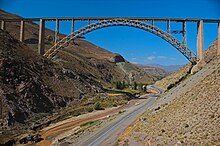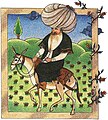Khoy
Khoy
UTC+3:30 (IRST) | |
|---|---|
| Area code | 044-3 |
| Website | www |
Khoy (
At the 2006 census, its population was 178,708 in 45,090 households.[7] The following census in 2011 counted 200,958 people in 57,149 households.[8] The latest census in 2016 showed a population of 198,845 people in 59,964 households.[3]
Khoy is located north of the province's capital and largest city
Occupied since Median times, it shares a long history as an important Christian center.[11]
History
Khoy was named in ancient times for the salt mines that made it an important spur of the Silk Route.[11] 3000 years ago, a city existed on the area where Khoy is located nowadays, but its name became Khoy only in the 14th centuries ago.[12] In 714 BC, Sargon II passed the region of which Khoy is part of in a campaign against Urartu.[12]
During the reign of
In the
Scholars such as Josef Markwart consider Khoy to be the identical to the Gobdi station mentioned in the Tabula Peutingeriana.[13]
One of the important historic elements of the city is
By the first half of the 11th century the
In 1210, the city was conquered by the forces of
The city was ruled over by Malika, wife of Jalal al-Din Mangburni after his conquest of the city in the late 1220s.[18]
Modern period

In the wake of the demise of the
Until 1828, Khoy had a large number of
With the advent of the 1910s, Khoy was occupied by Ottoman troops, but they were completely expelled from the area by the Russians by 1911.[21] Khoy was one of the many cities in Iran which garrisoned Russian infantry and Cossacks.[21] The Russians retreated at the time of Enver Pasha's offensive in the Iran-Caucasus region, but returned in around early 1916, and stayed in the region up to the wake of the Russian Revolution.[21] In 1918, for a final brief period, the Ottomans took Khoy until the decisive end of World War I and the Armistice of Mudros.[21] In World War II, Khoy was again occupied by Soviet troops, who remained until 1946. After 1946 the city indefinitely became part of Iran and is located in the far northwest of the country.
Climate
| Climate data for Khoy (1991-2020, extremes 1981-2020)[i] | |||||||||||||
|---|---|---|---|---|---|---|---|---|---|---|---|---|---|
| Month | Jan | Feb | Mar | Apr | May | Jun | Jul | Aug | Sep | Oct | Nov | Dec | Year |
| Record high °C (°F) | 17.0 (62.6) |
20.2 (68.4) |
27.2 (81.0) |
32.0 (89.6) |
34.0 (93.2) |
38.3 (100.9) |
42.8 (109.0) |
41.6 (106.9) |
38.6 (101.5) |
32.2 (90.0) |
24.0 (75.2) |
21.4 (70.5) |
42.8 (109.0) |
| Mean daily maximum °C (°F) | 3.4 (38.1) |
7.1 (44.8) |
13.4 (56.1) |
19.2 (66.6) |
24.1 (75.4) |
29.8 (85.6) |
33.1 (91.6) |
33.3 (91.9) |
28.9 (84.0) |
21.7 (71.1) |
12.8 (55.0) |
5.6 (42.1) |
19.4 (66.9) |
| Daily mean °C (°F) | −1.5 (29.3) |
1.5 (34.7) |
7.3 (45.1) |
12.9 (55.2) |
17.5 (63.5) |
22.6 (72.7) |
25.8 (78.4) |
25.5 (77.9) |
20.8 (69.4) |
14.3 (57.7) |
6.6 (43.9) |
0.6 (33.1) |
12.8 (55.1) |
| Mean daily minimum °C (°F) | −6.0 (21.2) |
−3.7 (25.3) |
1.2 (34.2) |
6.3 (43.3) |
10.6 (51.1) |
14.6 (58.3) |
17.8 (64.0) |
17.3 (63.1) |
12.4 (54.3) |
7.2 (45.0) |
1.3 (34.3) |
−3.4 (25.9) |
6.3 (43.3) |
| Record low °C (°F) | −23.8 (−10.8) |
−23.2 (−9.8) |
−20.6 (−5.1) |
−8.0 (17.6) |
−0.2 (31.6) |
3.4 (38.1) |
9.8 (49.6) |
9.0 (48.2) |
2.0 (35.6) |
−3.4 (25.9) |
−15.7 (3.7) |
−25.4 (−13.7) |
−25.4 (−13.7) |
| Average precipitation mm (inches) | 15.0 (0.59) |
16.6 (0.65) |
29.4 (1.16) |
46.1 (1.81) |
47.1 (1.85) |
23.8 (0.94) |
9.7 (0.38) |
6.0 (0.24) |
10.1 (0.40) |
19.7 (0.78) |
25.6 (1.01) |
18.7 (0.74) |
267.8 (10.55) |
| Average precipitation days (≥ 1.0 mm) | 3.4 | 3.8 | 5.2 | 7.5 | 8.5 | 4.2 | 1.8 | 1.3 | 1.8 | 3.4 | 4.1 | 4.4 | 49.4 |
| Average rainy days | 2.1 | 3.1 | 7.3 | 11.6 | 10.4 | 4.8 | 2.2 | 2 | 2.6 | 5.7 | 5.7 | 3.9 | 61.4 |
| Average snowy days | 5 | 5.1 | 2.9 | 0.3 | 0 | 0 | 0 | 0 | 0 | 0.1 | 1.7 | 4 | 19.1 |
| Average relative humidity (%)
|
74 | 66 | 56 | 55 | 55 | 47 | 45 | 44 | 48 | 58 | 68 | 76 | 58 |
| Average dew point °C (°F) | −6.0 (21.2) |
−5.0 (23.0) |
−2.0 (28.4) |
2.7 (36.9) |
7.1 (44.8) |
9.4 (48.9) |
11.9 (53.4) |
11.2 (52.2) |
8.0 (46.4) |
5.0 (41.0) |
0.5 (32.9) |
−3.6 (25.5) |
3.3 (37.9) |
| Mean monthly sunshine hours | 117 | 146 | 183 | 204 | 254 | 317 | 344 | 335 | 289 | 224 | 167 | 113 | 2,693 |
| Source: | |||||||||||||
- ^ Rainy days calculated using parameters 46 and 71 from the first source. (days with rain showers and days with rain/drizzle)
Sights
Khoy is well known for the tomb of Shams Tabrizi, renowned Iranian poet and mystic.


-
city center square
-
Khoy bazaar
-
historical Kabiri House in Khoy
-
Khoy Airport
-
Stone gate of Khoy
-
Kabiri House
-
Kabiri House
-
Kabiri House
-
Mahlezan church
-
Serkis
-
Tomb of Shams Tabrizi
-
Tomb of Shams Tabrizi
-
Stone gate of Khoy
Famous places
- Tomb of Shams Tabrizi, Shams Tabrizi Tower
- Bastam and Bolourabad Castles
- Khatoon Bridge
- Old Stone Gate
- Old Bazaar
- Motallebkhan Mosque
- Mount Avrin
- Ghotour Iron Bridge[25]
- Surp Sarkis Church
- Pourya-ye Vali
Notable natives
For a complete list see: Category:People from Khoy
-
Mullah Nasreddin, satirical Sufi.
-
Jahan Shah, was the leader of the Kara Koyunlu oghuz Turks tribal federation in Azerbaijan and Arran.
-
Iranologistand a university professor.
-
Behrouz Vossoughi, is an Iranian actor.
Twin towns
See also
- Donboli(tribe)
- Khoy Khanate
- Nor Shirakan
- Zaravand
References
- ^ OpenStreetMap contributors (16 February 2024). "City, Khoy County" (Map). OpenStreetMap. Retrieved 16 February 2024.
- ^ "Xoy, Iran Page". Archived from the original on 7 March 2008. Retrieved 7 July 2008.
- ^ a b "Census of the Islamic Republic of Iran, 1395 (2016)". AMAR (in Persian). The Statistical Center of Iran. p. 04. Archived from the original (Excel) on 30 August 2022. Retrieved 19 December 2022.
- ^ "چوار کۆڵبەر لە سنورەکانی بانە و خۆی کوژران و برینداربون" (in Kurdish). 9 May 2020. Retrieved 1 August 2020.
- ^ Khoy can be found at GEOnet Names Server, at this link, by opening the Advanced Search box, entering "-3071618" in the "Unique Feature Id" form, and clicking on "Search Database".
- ^ Habibi, Hassan (7 July 1369). "Approval of the organization and chain of citizenship of the elements and units of the country divisions of West Azerbaijan province, centered in the city of Urmia". Lamtakam (in Persian). Ministry of Interior, Council of Ministers. Archived from the original on 20 December 2023. Retrieved 20 December 2023.
- ^ "Census of the Islamic Republic of Iran, 1385 (2006)". AMAR (in Persian). The Statistical Center of Iran. p. 04. Archived from the original (Excel) on 20 September 2011. Retrieved 25 September 2022.
- ^ "Census of the Islamic Republic of Iran, 1390 (2011)" (Excel). Iran Data Portal (in Persian). The Statistical Center of Iran. p. 04. Retrieved 19 December 2022.
- ^ encyclopaedia islamica:اهالی شهرستان خوی به زبان ترکی سخن میگویند (صدراییخویی، 1373ش، ص 65)
- ^ Encyclopedia of Islamic World:به جز ساکنان حاشیه غربی شهرستان خوی که بیشتر کرد هستند؛ اکثریت جمعیت منطقه (بیش از ۹۰٪) شیعه دوازده امامیاند. کردهای این منطقه بیشتر به صورت عشایری زندگی میکنند و از دو طایفه مستقل کرهسنی و مدرومی هستند
- ^ ISBN 1742203493
- ^ a b c d e f Lida Balilan Asl, Elham Jafari. "Khoy's Expansion from Early Islam to Late Qajar According to Historical Documents" published spring 2013. vol 3
- ^ Manandian 1965, p. 113.
- ISBN 978-0-521-05735-6.
- ISBN 978-1841624020.
- ^ Salia, Kalistrat (1983). History of the Georgian nation. Madison, WI: University of Wisconsin. p. 181.
- ISBN 978-1598843361.
- ^ Tamta's World by Anthony Eastmond, page 108
- ISBN 978-0810866065.
- ^ a b Smith noted that the city had between 4000 and 7000 Muslim families, while only about 100 Armenian families were left. Smith, Eli (1834). Missionary Researches in Armenia: Including a Journey through Asia Minor, and into Georgia and Persia. G. Wightmann. p. 315.
- ^ a b c d Atabaki 2006, p. 70.
- ^ "Climate: Khoy - Climate graph, Temperature graph, Climate table". Climate-Data.org. Retrieved 9 September 2013.
- National Oceanic and Atmosoheric Administration. Retrieved 24 April 2024.
WMO number: 40703
- National Oceanic and Atmosoheric Administration. p. 26. Retrieved 24 April 2024.
WMO number: 40703
- ^ "Ghotour Valley Bridge". American Bridge Company. Archived from the original on 23 February 2013. Retrieved 25 March 2013.
- ^ "Rumi Remembered in Birthplace of Shams". Archived from the original on 7 April 2015. Retrieved 21 March 2015.
Sources
- ISBN 978-1860649646.
- Gledhill, Kevin (2022). "Khoy (Ḵoy)". In Yarshater, Ehsan (ed.). Encyclopædia Iranica, Online Edition. Encyclopædia Iranica Foundation.
- Manandian, Hakop (1965). Garsoïan, Nina (ed.). The Trade and Cities of Armenia in Relation to Ancient World Trade. Livraria Bertrand. (registration required)



















